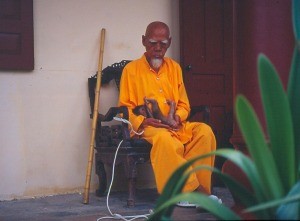The Gautama Buddha, over 25 centuries ago, commended frugality. As an example, he taught the first monks and nuns to make their robes from "pure cloth" that is cloth that no one wanted: scavenged from rubbish heaps and cremation grounds, these were remnants that had been chewed by rats or oxen, scorched by fire, soiled by childbirth, or used as a shroud to wrap the dead.
Only six kinds of fabric were permitted: plant fiber, cotton, silk, animal hair, hemp, or a combination of several. The unusable parts were cut away, and the cloth was washed. Then, the monks and nuns dyed the fabric by boiling it with fruits, vegetable matter (roots and tubers, bark, flowers, leaves) and spices, such as turmeric, saffron, curry, cumin, and paprika.
Originally the scraps were stitched together piecemeal into a rectangle large enough to surround the body. But one day the Buddha requested a robe cut and sewn in the design of a rice field. The resultant pattern (strips of cloth "paddies" separated by narrower strips "paths") has been repeated on monks' robes in most schools of Buddhism ever since.
The monk used his robe: "only for to ward off heat; for the sake of warding off cold; for the sake of warding off the touch of mosquitoes, flies, the wind, the sun, and creeping creatures; for the purpose of covering up the privies out of mortal shame." Most of all, the robes reminded the wearer (and still do, I'm sure) that he or she is a member of a larger universal and spiritual community.
Thrifty use of the robes by the monks (according to the monastic rules) followed this order: "When new robes [were] received, the old robes [were] used as coverlets; the old coverlets as mattress covers; the old mattress covers as rugs; the old rugs as dusters; and the tattered dusters [were] kneaded with clay and used to repair cracked floors and walls. Thus nothing [was] wasted."
As I see it, the monastic robes had many "lives." Take one made from a shroud, for example. It started as a seed; then it became a cotton plant, threads, a burial sheet, a robe, a blanket, a mattress cover, a rug, and finally, stuffing for cracks. That is ten lives there, but who knows how many came before or after.
I believe that nothing ceases to be; it simply transforms, recycles, reincarnates. Maybe even we do.
By Viaux from Miami, FL

In today's world we could use the resources available to take a few minutes each day to recycle. So much is thrown away or littering our planet and we could save our planet very easily by not being so wasteful.